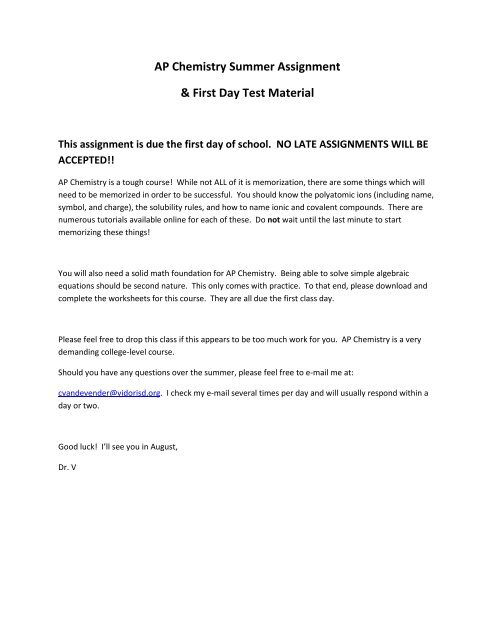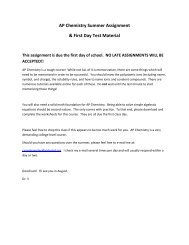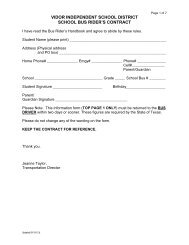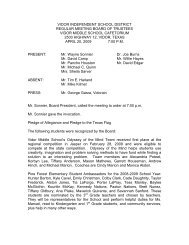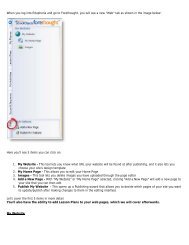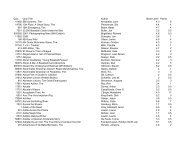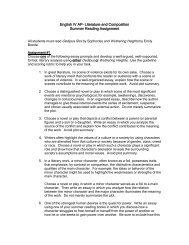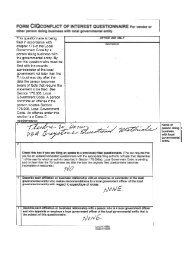AP Chemistry Summer Assignment & First Day Test Material
AP Chemistry Summer Assignment & First Day Test Material
AP Chemistry Summer Assignment & First Day Test Material
You also want an ePaper? Increase the reach of your titles
YUMPU automatically turns print PDFs into web optimized ePapers that Google loves.
<strong>AP</strong> <strong>Chemistry</strong> <strong>Summer</strong> <strong>Assignment</strong><br />
& <strong>First</strong> <strong>Day</strong> <strong>Test</strong> <strong>Material</strong><br />
This assignment is due the first day of school. NO LATE ASSIGNMENTS WILL BE<br />
ACCEPTED!!<br />
<strong>AP</strong> <strong>Chemistry</strong> is a tough course! While not ALL of it is memorization, there are some things which will<br />
need to be memorized in order to be successful. You should know the polyatomic ions (including name,<br />
symbol, and charge), the solubility rules, and how to name ionic and covalent compounds. There are<br />
numerous tutorials available online for each of these. Do not wait until the last minute to start<br />
memorizing these things!<br />
You will also need a solid math foundation for <strong>AP</strong> <strong>Chemistry</strong>. Being able to solve simple algebraic<br />
equations should be second nature. This only comes with practice. To that end, please download and<br />
complete the worksheets for this course. They are all due the first class day.<br />
Please feel free to drop this class if this appears to be too much work for you. <strong>AP</strong> <strong>Chemistry</strong> is a very<br />
demanding college-level course.<br />
Should you have any questions over the summer, please feel free to e-mail me at:<br />
cvandevender@vidorisd.org. I check my e-mail several times per day and will usually respond within a<br />
day or two.<br />
Good luck! I’ll see you in August,<br />
Dr. V
1+ Ions<br />
NH 4<br />
+<br />
1- Ions<br />
NO 2<br />
-<br />
NO 3<br />
-<br />
HSO 4<br />
-<br />
OH -<br />
CN -<br />
MnO 4<br />
-<br />
HCO 3<br />
-<br />
ClO -<br />
ClO 2<br />
-<br />
ClO 3<br />
-<br />
ClO 4<br />
-<br />
BrO 3<br />
-<br />
IO 3<br />
-<br />
IO 4<br />
-<br />
C 2 H 3 O 2<br />
-<br />
H 2 PO 4<br />
-<br />
2- Ions<br />
CO 3<br />
2-<br />
SO 3<br />
2-<br />
SO 4<br />
2-<br />
S 2 O 3<br />
2-<br />
O 2<br />
2-<br />
CrO 4<br />
2-<br />
Ammonium ion<br />
nitrite<br />
nitrate<br />
hydrogen sulfate (bisulfate)<br />
hydroxide<br />
cyanide<br />
permanganate<br />
Common Polyatomic Ions<br />
hydrogen carbonate (bicarbonate)<br />
hypochlorite<br />
chlorite<br />
chlorate<br />
perchlorate<br />
bromate<br />
iodate<br />
Cr 2 O 7 2- dichromate<br />
HPO 4<br />
2-<br />
3- Ions<br />
PO 4<br />
3-<br />
AsO 4<br />
3-<br />
periodate<br />
acetate<br />
dihydrogen phosphate<br />
carbonate<br />
sulfite<br />
sulfate<br />
thiosulfate<br />
peroxide<br />
chromate<br />
hydrogen phosphate (biphosphate)<br />
phosphate<br />
arsenate
Solubility Rules<br />
1. All compounds containing the alkali metal cations and the ammonium ion are soluble.<br />
2. All compounds containing NO 3 - , ClO 4 - , ClO 3 - , and C 2 H 3 O 2 - anions are soluble.<br />
3. All chlorides, bromides, and iodides are soluble except those containing Ag + , Pb 2+ , or<br />
Hg 2 2+ .<br />
4. All sulfates are soluble except those containing Hg 2 2+ , Pb 2+ , Sr 2+ , Ca 2+ , or Ba 2+ .<br />
5. All hydroxides are insoluble except compounds of the alkali metals, Sr 2+ , Ca 2+ , and Ba 2+ .<br />
6. All compounds containing PO 4 3+ , S 2- , CO 3 2- , and SO 3 2- are insoluble except those that<br />
also contain alkali metals or NH 4 + .<br />
There are a lot of online quizzes available to help you learn these rules.
<strong>AP</strong> Chem <strong>Summer</strong> <strong>Assignment</strong> Worksheet #1<br />
Measurements and Calculations<br />
Mixed Metric and American Conversions: Show ALL work, using dimensional<br />
analysis, and answer in scientific notation.<br />
1. 0.014 kilograms to centigrams<br />
2. 4.305 liters to milliliters<br />
3. 61.2 microliters to milliliters<br />
4. 5.48 centimeters to millimeters<br />
5. 3.80 km to meters<br />
6. 40.6 decimeters to decameters<br />
7. 3.88 miles to hectometers<br />
8. 2.994 ounces to milligrams<br />
9. 926 tons to Megagrams<br />
10. How many centimeters are there<br />
in 7.88 x 10 2 feet?<br />
11. Convert 6.775 yards to<br />
picometers.<br />
12. Convert 5.47 x 10 -2 hectograms<br />
to ounces<br />
13. How many centimeters are there<br />
in 51.004 miles<br />
Density: Show ALL work, use dimensional analysis when necessary.<br />
14. If an unknown solid weighs 84.0 grams and occupies 30.0 cm 3 of space, what<br />
is its density?<br />
15. What is the mass of a liquid having a density of 1.50 g/ml and a volume of 3.5<br />
liters?<br />
16. What volume would a 200 gram sample of gold have if its density is known to<br />
be 20.5 g/cm 3 ?<br />
17. A solid block of substance is 74.0 cm by 55.0 cm by 29.0 cm and it weighs 625<br />
kg. Assuming that it did not chemically react with water nor dissolve in it, would it<br />
float in water? Show your work.<br />
18. A gas has a volume of 7.0 liters and a mass of 4.44 X 10 5 micrograms. What<br />
is its density?<br />
19. A certain liquid has a density of 0.855 g/ml. How many LITERS would weigh<br />
1.00 kg?
<strong>AP</strong> Chem <strong>Summer</strong> <strong>Assignment</strong> Worksheet #1<br />
Dimensional Analysis (Exercising Problem Solving Skills): Show ALL work, using<br />
dimensional analysis, Report answers using the correct number of significant<br />
figures.<br />
20. The record long jump is 349.5 inches. Convert this to meters. There are 2.54<br />
cm in an inch.<br />
21. A car traveling 55.0 miles per hour. Convert this to meters per second. 1 mile<br />
= 1.61 km.<br />
22. How many milligrams are there in a 5.00 grain aspirin tablet? 1 grain =<br />
0.00229 ounces. There are 454 grams/pound and 16.0 ounces/pound.<br />
23. Mercury has a density of 13.54 g/mL. How many milliliters would 100. grams<br />
fill?<br />
24. In 1980, the US produces 18.4 billion pounds (1.84 X 1010 lbs) of phosphoric<br />
acid to be used in the manufacture of fertilizer. The average cost of the acid is<br />
$318/ton. (1 ton = 2000 lbs) What was the total value of the phosphoric acid<br />
produced?<br />
25. On planet Zizzag, city Astric is 35.0 digs from city Betrek. The latest in<br />
teenage transportation is a Zeka which can travel a maximum of 115 millidigs/zip.<br />
On Zizzag their time system divides each dyne into 25.0 zips. How many dyne will<br />
it take Pezzi to get from Astric to Betrek to see his girlfriend?<br />
26. While prospecting in the North Woods, Joe found a gold nugget which had a<br />
density of 19.2 g/cm3. Joe dropped the gold into water in a graduated cylinder, the<br />
water level increased by 15.0 mL. How many grams of gold did he have?<br />
27. Light travels at a speed of 3.00 X 1010 cm/sec. What is the speed of light in<br />
km/hr?<br />
28. A cheetah has been clocked at 112 km/hr over a 100. meter distance. What is<br />
this speed in m/sec?
<strong>AP</strong> Chem <strong>Summer</strong> <strong>Assignment</strong> Worksheet #2<br />
Stoichiometry<br />
Complete the following problems using dimensional analysis. Balance all of the equations<br />
that need to be balanced.<br />
1. In the decomposition of sodium hydroxide, how many moles of sodium hydroxide are<br />
needed to produce 30.0 moles of water?<br />
2. In the single replacement reaction of lithium and magnesium nitrate, what mass of<br />
lithium combines with 75.0 grams of magnesium nitrate?<br />
3. How many grams of lead (II) nitrate are needed to produce 60.0 grams of potassium<br />
nitrate in the double replacement reaction of potassium iodide and lead (II) nitrate.<br />
4. In the synthesis reaction of zinc(II) and sulfur, what mass of zinc (II) sulfide is produced<br />
from 100.0 grams of sulfur?<br />
5. A synthesis reaction of calcium and oxygen was completed in a lab and 234.9 grams of<br />
calcium oxide were produced from 75.00 grams of oxygen. What is the percent yield?<br />
6. In the single replacement reaction of magnesium and aluminum phosphate, if 7.00<br />
moles of magnesium react, how many moles of aluminum phosphate would be needed?<br />
7. When methane and oxygen react (complete combustion reaction) how many grams of<br />
water would be produced from 25.0 grams of methane?<br />
8. A 26.3 gram sample of potassium chlorate decomposed and produced 9.45 grams of<br />
oxygen. What is the percent yield for oxygen?<br />
9. If 7.40 grams of calcium hydroxide react with nitric acid to produce 2.01 grams of water,<br />
what is the percent yield?<br />
10. Lime, CaO, reacts with hydrochloric acid to form calcium chloride and water. How<br />
many moles of HCl would be required to react with 7.5 moles of lime? How many moles of<br />
water would be formed?
<strong>AP</strong> Chem <strong>Summer</strong> <strong>Assignment</strong> Worksheet #2<br />
For each of the following write balanced chemical equations and then solve the problem.<br />
11. What is the maximum number of grams of PH 3 that can be formed when 6.2 g of<br />
phosphorus reacts with 6.0 g of hydrogen to form PH 3 ?<br />
12. Copper is formed when aluminum reacts with cupric sulfate in a single-replacement<br />
reaction. How many grams of copper can be obtained when 29.0 g of Al reacts with 156 g<br />
or cupric sulfate?<br />
13. If you begin with 1250 g of N 2 and 225 of H 2 in the reaction that forms ammonia gas<br />
(NH 3 ), how much ammonia will be formed? What is the limiting reagent? How much of the<br />
reagent is left when the maximum amount of ammonia is formed?
Chemical Formulas<br />
See http://www.wise.k12.va.us/jjk/<strong>Chemistry</strong>/formula.htm for help<br />
1. Write formulas for the following: 2. Hame each of the following:<br />
a. barium sulfate ____________________ a. CuSO 4 ____________________<br />
b. ammonium chloride_______________ b. PCl 3 ______________________<br />
c. chlorine monoxide_________________ c. Li 3 N_______________________<br />
d. silicon tetrachloride________________ d. BaSO 3 ____________________<br />
e. magnesium fluoride________________ e. N 2 F 4 _______________________<br />
f. sodium oxide______________________ f. KClO 4 ______________________<br />
g. sodium peroxide___________________ g. NaH_______________________<br />
h. copper (I) oxide____________________ h. (NH 4 ) 2 Cr 2 O 7_______________________<br />
i. zinc sulfide_________________________ i. HNO 2 * ______________________<br />
j. potassium carbonate_________________ j. Sr 3 P 2 _______________________<br />
k. hydrobromic acid____________________ k. Mg(OH) 2 ____________________<br />
l. perchloric acid_______________________ l. Al 2 S 3 _______________________<br />
m. lead (II) acetate_____________________ m. AgBr______________________<br />
n. sodium permanganate________________ n. P 4 O 10 _______________________<br />
o. lithium oxalate_______________________ o. HC 2 H 3 O 2 * ___________________<br />
p. potassium cyanide____________________ p. CaI 2 _________________________<br />
q. iron (III) hydroxide____________________ q. MnO 2 ______________________<br />
r. silicon dioxide________________________ r. Li 2 O_________________________<br />
s. nitrogen trifluoride____________________ s. FeI 3 ________________________<br />
t. chromium (III) oxide___________________ t. Cu 3 PO 4 _______________________<br />
u. calcium chlorate______________________ u. PCl 5 ________________________<br />
v. sodium thiocyanate___________________ v. NaCN_______________________<br />
w. nitrous acid__________________________ w. HF * _________________________<br />
* Name as acids


